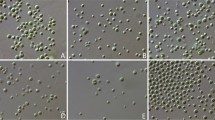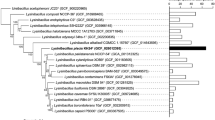Abstract
Bacterial communities were identified from the accessory nidamental glands (ANGs) of European and Western Pacific squids of the families Loliginidae and Idiosepiidae, as also in the egg capsules, embryo and yolk of two loliginid squid species, and in the entire egg of one idiosepiid squid species. The results of phylogenetic analyses of 16S RNA gene (rDNA) confirmed that several phylotypes of α-proteobacteria, γ-proteobacteria and Cytophaga–Flavobacteria–Bacteroides phylum were present as potential symbiotic associations within the ANGs. Several identified clones were related to reference strains, while others had no known close relatives. Gram positive strains were rare in loliginid squids. Several bacterial groups may play important roles in the function of the ANGs, such as production of the toxic compounds involved in egg protection and carotenoid pigments. Within the eggs, no bacteria were associated with embryo or yolk of Loligo vulgaris and Sepioteuthis lessoniana, but α- and γ-proteobacteria were present in the egg capsules. Most bacterial strains detected in the egg capsules were the same as those found in the ANGs. The cephalopods of temperate regions (European cuttlefishes and the squid L. vulgaris) appear to be associated with one Agrobacterium strain (Agro2) while tropical-subtropical strains (Asian and Australian loliginids) are associated with Silicibacter-related strains, suggesting a biogeographic clustering for the Agrobacterium-like strains.



Similar content being viewed by others
References
Amann RI, Krumholz L, Stahl DA (1990) Fluorescent-oligonucleotide probing of whole cells for determinative, phylogenetic, and environmental studies in microbiology. J Bacteriol 172:762–770
Barbieri E, Barry K., Child A, Wainwright N (1997) Antimicrobial activity in the microbial community of the accessory nidamental gland and egg capsules of Loligo pealei (Cephalopoda: Loliginidae)). Biol Bull 193:275–276
Barbieri E, Paster BJ, Hughes D, Zurek L, Moser DP, Teske A, Sogin ML (2001) Phylogenetic characterization of epibiotic bacteria in the accessory nidamental gland and egg of the squid Loligo pealei (Cephalopoda: Loliginidae). Environ Microbiol 3:151–167
Bloodgood R (1977) The squid accessory nidamental gland: ultrastructure and association with bacteria. Tissue Cell 9(2): 197–208
Boettcher KJ, Barber BJ, Singer JT (2000) Additional evidence that juvenile oyster disease is caused by a member of the Roseobacter group and colonization of non affected animals by Stappia stellulata-like strains. Appl Environ Microbiol 66(9):3924–3930
Bonnaud L, Pichon D, Boucher-Rodoni R (2005) Molecular approach of Decabrachia phylogeny: is Idiosepius definitely not a sepiolid? Phuket mar biol Cent Res Bull (in press)
Felsenstein J (1993) Phylip Version 3.5c. University of Washington, Seattle. [Online] http://sdmc.krdl.ord.sg:8080/~lxzhang/phylip)
Gerhard P, Murray RE, Wood WA, Krieg R (eds) (1994) Methods for general and molecular bacteriology. American Society for Microbiology, Washington DC
Gonzalez JM, Covert JS, Whitman WB, Henriksen JR, Mayer F, Scharf B, Schmitt R, Buchan A, Fuhrman JA, Kiene RP, Moran MA (2003) Silicibacter pomeroy sp nov and Roseovarius nubinhibens sp nov, dimethylsulfoniopropionate-demethylating bacteria from marine environments. Int J Syst Evol Microbiol 53:1261–1269
Good IJ (1953) The population frequencies of species and the estimation of population parameters. Biometrica 40:237–264
Grigioni S, Boucher-Rodoni R, Demarta A, Tonolla M, Peduzzi R (2000) Phylogenetic characterisation of bacterial symbionts in the accessory nidamental glands of the sepioid S officinalis (Cephalopoda: Decapoda). Mar Biol 136:217–222
Hahn D, Amann RI, Ludwig W, Akkermans ADL, Schleifer K-H (1992) Detection of micro-organisms in soil after in situ hybridisation with rRNA-targeted fluorescently labelled nucleotides. J Gen Microbiol 138:879–887
Huber T, Faulkner G, Hugenholtz P (2004) Bellerophon: a program to detect chimeric sequences in multiple sequence alignments. Bioinformatics 20:2317–2319
Kaufman MR, Ikeda Y, Patton C, Van Dykhuizen G, Epel D (1998) Bacterial symbionts colonize the accessory nidamental gland of the squid Loligo opalescens via horizontal transmission. Biol Bull 194:36–43
Kimura M (1980) A simple method for estimating evolutionary rates of base substitutions through comparative studies of nucleotide sequences. J Mol Evol 16:111–120
Lum-Kong A, Hastings T (1992) The accessory nidamental glands of Loligo forbesi (Cephalopoda, Loliginidae). Characterization of symbiotic bacteria and preliminary experiments to investigate factors controlling maturation. J Zool Lond 228:395–403
Maidak BL, Olsen GJ, Larsen N, Overbeek R, McCaughey MJ, Woese CR (1997) The RDP (ribosomal database project). Nucleic Acids Res 25:109–111
Manz W, Amann R, Ludwig W, Wagner M, Schleifer K-H (1992) Phylogenetic oligodeoxynucleotide probes for the major subclasses of proteobacteria: problems and solutions. Syst Appl Microbiol 15:593–600
McFall-Ngai MJ, Ruby EG (1991) Symbiotic recognition and subsequent morphogenesis as early events in an animal-bacterial mutualism. Science 254:1491–1494
McFall-Ngai MJ, Ruby EG (1998) Sepiolids and Vibrios: when first they meet. Bioscience 48(4):257–265
Nalepa CA, Bignell DE, Bandi C (2001) Detritivory, coprophagy, and the evolution of digestive mutualisms in Dictyoptera. Insect Soc 48: 194–201
Nishiguchi MK, Ruby EG, McFall-Ngai MJ (1998) Competitive dominance among strains of luminous bacteria provides an unusual form of evidence for parallel evolution in sepiolid squid—Vibrio symbioses. Appl Environ Microbiol 64(9):3209–3213
Olsen GJ, Matsuda H, Hagstrom R, Overbeek R (1994) FastDNAmL: a tool for construction of phylogenetic trees of DNA sequences using maximum likelihood. Comput Appl Biosci 10:41–48
Pearson WR, Lipman DJ (1988) Improved tools for biological sequence comparison. Proc Natl Acad Sci USA 85(8):2444–2448
Pichon D, Grigioni S, Favet J, Boucher-Rodoni R (2005) Symbiotic associations between Cephalopods and the Roseobacter bacteria strain. Phuket Mar Biol Cent Res Bull (in press)
Roper CFE, Sweeney MJ, Nauen CE (1984) Cephalopods of the world. An annotated and illustrated catalogue of species of interest to fisheries. FAO fisheries synopsis, vol 3, no. 125. FAO, Rome
Stahl DA, Amann R (1991) Development and application of nuceic acid probes in bacterial systematics. In: Stackenbrandt E, Goodfellow M (eds) Nucleic acid techniques in bacterial systematics. Wiley, Chichester, pp 205–248
Thompson JD, Higgins DG, Gibson TJ (1994) ClustalW: improving the sensitivity of progressive multiple sequence alignment through sequence weighting, position specific gap penalties and Weight matrix choice. Nucleic Acids Res 22:4673–4680
Uchino Y, Hirata A, Yokota A, Sugiyama J (1998) Reclassification of marine Agrobacterium species: proposals of Stappia stellulata gen nov, comb nov, Stappia aggregate sp nov, nom rev, Ruegeria atlantica gen nov, comb nov, Ruegeria gelatinovora comb nov, Ruegeria algicola comb nov, and Ahrensia kieliensis gen nov sp nov, nom rev. J Gen Appl Microbiol 44:201–210
Van den Branden C, Richard A, Lemaire J, Decleir W (1978) La glande nidamentaire accessoire de Sepia officinalis L : analyses biochimiques des pigments des bactéries symbiotiques. Ann Soc R Zool Belg 108:123–139
Zarda B, Hahn D, Chatzinotas A, Schönhuber W, Neef A, Amann R, Zeyer J (1997) Analysis of bacterial community structure in bulk soil by in situ hybridization. Arch Microbiol 168:185–192
Acknowledgements
The authors wish to thank: Dr. C.C. Lu for his help during collection of specimens in Taiwan and for providing Loliolus samples; Dr. J. Nabhitabhata for Idiosepius biserialis egg samples from Thailand; J. Finn for assistance in field collection in Australia; Dr. H. Rybarczyk for assistance in statistical analysis. This work was supported by a CNRS grant (PICS 743) which provided 3 months salary and funds for field collection in Australia for the second author. The experiments complied with the current laws of the country in which the experiments were performed.
Author information
Authors and Affiliations
Corresponding author
Additional information
Communicated by S.A. Poulet
Rights and permissions
About this article
Cite this article
Pichon, D., Gaia, V., Norman, M.D. et al. Phylogenetic diversity of epibiotic bacteria in the accessory nidamental glands of squids (Cephalopoda: Loliginidae and Idiosepiidae). Marine Biology 147, 1323–1332 (2005). https://doi.org/10.1007/s00227-005-0014-5
Received:
Accepted:
Published:
Issue Date:
DOI: https://doi.org/10.1007/s00227-005-0014-5




